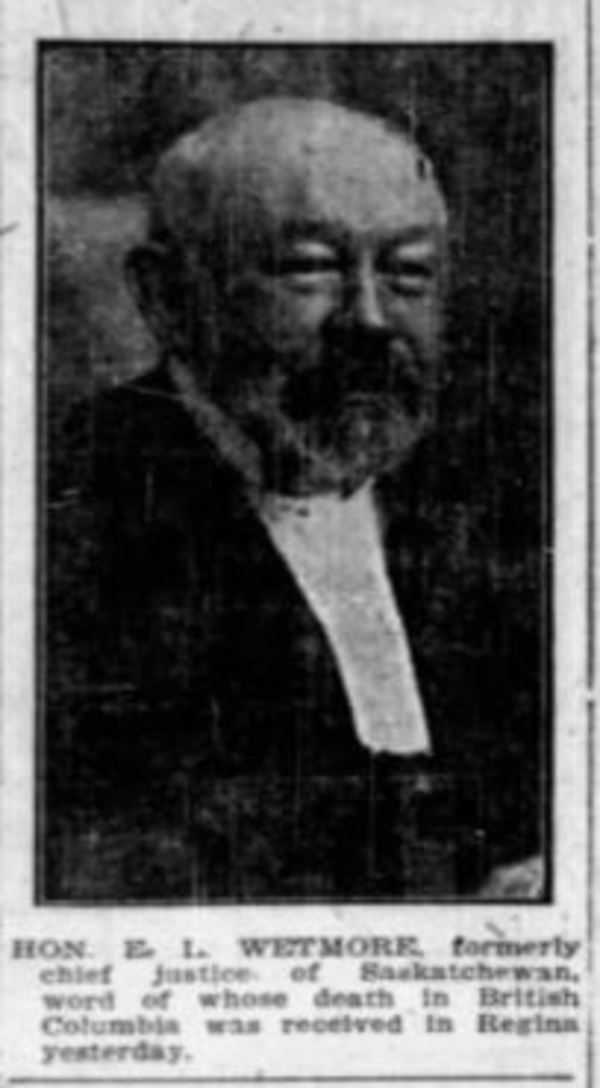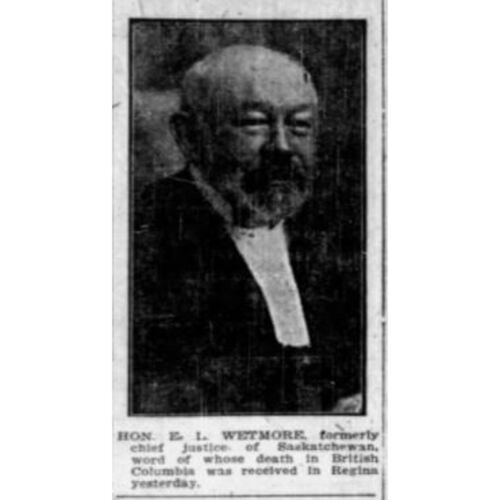
Source: Link
WETMORE, EDWARD LUDLOW, lawyer, politician, and judge; b. 24 March 1841 in Fredericton, son of Charles Peters Wetmore, a lawyer and clerk of the House of Assembly, and Sarah Burr Ketchum; m. 25 April 1872 Eliza Jane Dickson in Oromocto, N.B., and they had one daughter and two sons; d. 19 Jan. 1922 in Victoria.
Educated at grammar schools in Fredericton and Gagetown, Edward L. Wetmore was granted the ba degree with honours by King’s College, Fredericton, in 1859. After studying in the law office of John Campbell Allen*, he was admitted to practice as an attorney in June 1863 and was called to the bar one year later. He practised in Sussex for five years before relocating in Fredericton, where he eventually entered the firm of John James Fraser* and Edward Byron Winslow, the leading legal office in the capital. Regarded by the Canadian biographical dictionary as “one of the foremost men of his age and profession in this part of the province, he being a well-read lawyer, a good logician and an effective speaker,” Wetmore would be named a federal qc in 1881.
While carrying on his practice, Wetmore served as deputy clerk of the crown from 1869 to 1882, mayor of Fredericton (“an efficient and popular executive”) from 1874 to 1876, a commissioner to revise the statutes of New Brunswick in 1877, and president of the Barristers’ Society in 1886 and 1887. From 1884 to 1887 he was a member of the senate of the University of New Brunswick, which would grant him an honorary lld in 1908. A Conservative in politics, Wetmore had been elected to the House of Assembly for York in 1882 and selected leader of the opposition in 1883. He was defeated in the general election of 1886.
In 1887 Wetmore was appointed a puisne judge of the Supreme Court of the North-West Territories for the district of Eastern Assiniboia and settled in Moosomin (Sask.). Considered by Edmonton lawyer Charles Coursolles McCaul “quite the strongest member of the Court,” he gained a reputation as a distinguished jurist, well versed in case law, both criminal and civil, stern but fair, whose emphasis on propriety and punctuality gave dignity to the court. His decisions, expressed in concise and cogent language, were only rarely reversed on appeal. He had a particular interest in civil procedure and his numerous procedural rulings helped shape the administration of justice in the west. In 1944 Hugh Amos Robson*, chief justice of the Manitoba Court of King’s Bench and a former attorney general of the North-West Territories, would recall that the prairies of Wetmore’s day presented considerable scope for the interpretation and application of laws. In 1889, in The Queen v. Nan-e-quis-a-ka, for example, Wetmore was required to rule on the status of marriages according to Indian custom; he concluded that they were valid in the Territories, and the court in banc subsequently supported his view. Wetmore also contributed much to the jurisprudence that emerged on the subject of the Torrens system of land registration, introduced throughout western Canada in the 1880s [see Louis William Coutlée*]. In 1907 he was appointed chief justice of the Supreme Court of Saskatchewan, “to the great satisfaction,” in Robson’s words, “of not only the bench and bar, but of the whole population.” He held the position until his retirement in October 1912.
In addition to attending to his judicial responsibilities, Wetmore chaired the royal commissions to inquire into the “Herchmer Scandals” in 1891–92 [see Lawrence William Herchmer*] and to revise the statutes of Saskatchewan in 1906–9; in 1897–98 he and fellow judge Hugh Richardson* had constituted a commission to consolidate the ordinances of the North-West Territories, and in 1909 he was one of two commissioners appointed to investigate the contracts the Saskatchewan government had signed the previous year with Morang and Company for school readers. In 1907 he had been elected, without a dissenting voice, chancellor of the new University of Saskatchewan in Saskatoon, an office he held until 1917. A stalwart member of the Church of England, Wetmore served as delegate to the Diocesan Church Society, substitute delegate to the synod, and treasurer of the diocese of Qu’Appelle. He was also a third-degree freemason.
After his retirement Wetmore moved to British Columbia. His wife had died in an accident in 1905, the victim of runaway horses, and he lived in Victoria with his daughter Mary and her husband, Albert Edward Christie. In 1913 he was named chair of the royal commission on Indian affairs for the province of British Columbia [see James Andrew Joseph McKenna*], and in 1916 he was appointed to a commission to determine whether contracts for roads entered into by the Saskatchewan government were fraudulent in any respect. Wetmore died in 1922 after a long illness, survived by his daughter and sons J. Allen and Valentine H., both then of Vancouver. His funeral was held in St Alban’s Church in Moosomin on 25 January and his body was interred beside his wife’s in the North Cemetery there.
A grateful University of Saskatchewan had awarded him an honorary dcl in 1919 and, after his death, the board of governors at its meeting of 3 April 1922 placed on record its appreciation of the services the late chief justice had rendered to the province and the university. The board minute, in part, states: “Both enjoy in rich measure the results of his great common sense, his judiciousness and his high sense of public duty in shaping those fundamental traditions which give character and direction to the activities of two of the most influential institutions of the State – the judiciary and the University. . . . during the critical period of selecting a site and adopting policies for the new University, he exercised a large influence in directing public opinion to place the good of the University above all sectarian, political and local interests. His name will ever be associated in our history, with those institutions which establish and foster justice, intelligence, and respect for law in the life of the people of this Province.”
PANB (Fredericton), MC 1156. Saskatchewan Arch. Board (Saskatoon), Clippings files, Biogs. Univ. of Sask. Arch. (Saskatoon), RG M-1, 3 April 1922. Daily Gleaner (Fredericton), 20 Jan. 1922. Morning Leader (Regina), 20 Jan. 1922. W. F. Bowker, “Stipendiary magistrates and Supreme Court of the North-West Territories, 1876–1907,” Alberta Law Rev. (Edmonton), 26 (1987–88): 245–86. Canadian biographical dictionary and portrait gallery of eminent and self-made men (2v., Toronto, 1880–81), 1. Canadian men and women of the time (Morgan; 1898). Michael Hayden, Seeking a balance: the University of Saskatchewan, 1907–1982 (Vancouver, 1983). L. [A.] Knafla and Richard Klumpenhouwer, Lords of the western bench: a biographical history of the supreme and district courts of Alberta, 1876–1990 (Calgary, 1997). C. C. McCaul, “Precursors of the bench and bar in the western provinces,” Canadian Bar Rev. (Toronto), 3 (1925): 25–40. Political appointments and judicial bench (Coté). The Queen v. Nan-e-quis-a-ka (1889), Territories Law Reports (Toronto), 1: 211–16. H. A. Robson, “Edward Ludlow Wetmore,” Canadian Bar Rev. (Ottawa), 22 (1944): 442–49. Who’s who and why, 1917–18.
Cite This Article
Stanley D. Hanson, “WETMORE, EDWARD LUDLOW,” in Dictionary of Canadian Biography, vol. 15, University of Toronto/Université Laval, 2003–, accessed December 30, 2025, https://www.biographi.ca/en/bio/wetmore_edward_ludlow_15E.html.
The citation above shows the format for footnotes and endnotes according to the Chicago manual of style (16th edition). Information to be used in other citation formats:
| Permalink: | https://www.biographi.ca/en/bio/wetmore_edward_ludlow_15E.html |
| Author of Article: | Stanley D. Hanson |
| Title of Article: | WETMORE, EDWARD LUDLOW |
| Publication Name: | Dictionary of Canadian Biography, vol. 15 |
| Publisher: | University of Toronto/Université Laval |
| Year of publication: | 2005 |
| Year of revision: | 2005 |
| Access Date: | December 30, 2025 |



